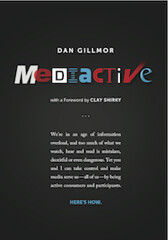 Dan Gillmor is such a smooth writer and so media savvy that we readers hardly realize he is hurling a challenge at all of us, from average citizens to professionals, in his new book, Mediactive, which can be purchased at store and online outlets or can be downloaded at http://mediactive.com.
Dan Gillmor is such a smooth writer and so media savvy that we readers hardly realize he is hurling a challenge at all of us, from average citizens to professionals, in his new book, Mediactive, which can be purchased at store and online outlets or can be downloaded at http://mediactive.com.
Gillmor identified the phenomenon of “consumer as creator” in his first book, We The People, published in 2004. His latest book is a practical, common-sense 2.0 version, assuming we no longer are receptacles of information but active participants in the process, who are called on to break out of our “comfort zone” like a chick cracking open its shell.
 A longtime high-tech newsaper columnist now blogging, teaching and directing a media center at Arizona State University, Gillmor makes a positive case for being mediactive (his word), then tells you how and why. Journalists use a technique called a “nut graf”, a single paragraph that sums up the essence of an article. You don’t have to wait long with Gillmor. On Page 3 he writes:
A longtime high-tech newsaper columnist now blogging, teaching and directing a media center at Arizona State University, Gillmor makes a positive case for being mediactive (his word), then tells you how and why. Journalists use a technique called a “nut graf”, a single paragraph that sums up the essence of an article. You don’t have to wait long with Gillmor. On Page 3 he writes:
Information overflow requires us to take an active approach to media, in part to manage the flow pouring over us each day, but also to make informed judgments about the significance of what we see. Being passive receivers of news and information, our custom through the late 20th Century era of mass media, isn’t adequate in the new century’s Digital Age mediasphere, where information comes at us from almost everywhere, and from almost anyone.
With that gauntlet thrown down, Gillmor explains the positive side ten pages later: “Above all, hands-on mediactivity is satisfying, often fun. By being mediactive, you’ll get used to gauging the reliability of what you see, pushing deeper into various topics and following the many threads of arguments to reach your own conclusions — not on everything, of course, but on the issues that you care about the most. And when you’ve made that process part of your life, you’ll have trouble waiting for the next break in your day so you can get back to the satisfaction that it brings.”
The aspect of this book that is most compelling to me concerns the phrase, “gauging the reliability”. Gillmor reminded me of my father (although I am old enough to be Dan’s), who had a stern, curt answer anytime I asked him the meaning of a word or an issue: “Look it up,” he would say. Gillmor makes the case that the new consumer/creators are obliged to be skeptical about the information they absorb and take steps to verify it. He devotes a chapter to the principles of media consumption — often called “media literacy” — that include use of due diligence, exercising judgment, opening your mind, continually asking questions and learning media techniques.
He backs up these principles with the use of solid, revealing examples and insightful injection of nuances that reflect his experience grappling with these issues in his own media journey. In some cases he doesn’t mince words, slamming home the axiom that “early news is so frequently wrong” that a heavy dose of skepticism is called for. Gillmor’s associate, Ethan Zuckerman of the Berkman Center, suggests that it isn’t just the early reporting that often is in error but also the accepting mindset of many news consumers in early stages of fast-moving, developing stories. Gillmor says that mindset must change.
Somehow Gillmor does an exhaustive job of outlining how to be media savvy in only 180 pages. He deliberately omits an index, given that a computer search can easily be done on the text at http://mediactive.com. But that means booting up, going to the site, calling up the book and searching. An index of a few pages at the end of the book would seem to be an easily achieved reader service.
Shortly after reading the book, I had an email exchange with a friend who sent me the following: “We have a whole generation or two that has gone over to cell phones, tweeting, and facebook, which means they don’t have the interest or attention span for anything but headlines.” I was Gillmor-skeptical.
The friend then added (and you could almost see him smiling) that he realized he should be accepting of this new trend, because at the local pool hall he overheard someone say that, “Where ignorance is bliss, ’tis folly to be wise.”
That sent me to Wikipedia (or was it Google?) to check my memory that the author of that line was poet Robert Graves. O no, It was poet Thomas Gray. I was skeptical of myself, and it paid off. Hey, I’m a mediactivist!
(Jack Driscoll is author of Couch Potatoes Sprout: The Rise of Online Community Journalism and is an adviser for the Center For the Future of Civic Media.)
